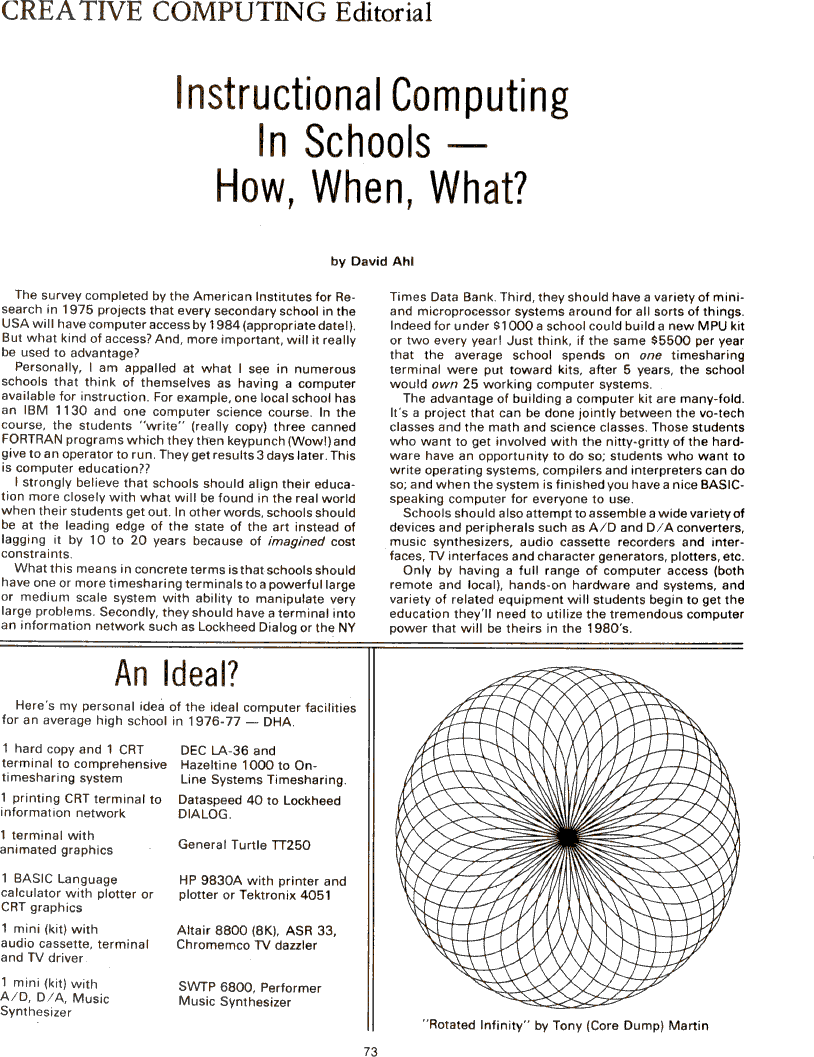by David H. Ahl

CREATIVE COMPUTING Editorial Instructional Computing In Schools - How, When, What? by David Ahl The survey completed by the American Institutes for Research in 1975 projects that every secondary school in the USA will have computer access by 1 984 (appropriate date!). But what kind of access? And, more important, will it really be used to advantage? Personally, I am appalled at what I see in numerous schools that think of themselves as having a computer available for instruction. For example, one local school has an IBM 1130 and one computer science course. In the course, the students "write" (really copy) three canned FORTRAN programs which they then keypunch(Wow!) and give to an operator to run. They get results 3 days later. This is computer education?? I strongly believe that schools should align their education more closely with what will be found in the real world when their students get out. ln other words, schools should be at the leading edge of the state of the art instead of lagging it by 10 to 20 years because of imagined cost constraints. What this means in concrete terms is that schools should have one or more timesharing terminals to a powerful large or medium scale system with ability to manipulate very large problems. Secondly, they should have a terminal into an information network such as Lockheed Dialog or the NY Times Data Bank. Third, they should have a variety of miniand microprocessor systems around for all sorts of things. Indeed for under $1000 a school could build a new MPU kit or two every year! Just think, if the same $5500 per year that the average school spends on one timesharing terminal were put toward kits, after 5 years, the school would own 25 working computer systems. The advantage of building a computer kit are many-fold. lt's a project that can be done jointly between the vo-tech classes and the math and science classes. Those students who want to get involved with the nitty-gritty of the hardware have an opportunity to do so; students who want to write operating systems, compilers and interpreters can do so; and when the system is finished you have a nice BASICspeaking computer for everyone to use. Schools should also attempt to assemble a wide variety of devices and peripherals such as A/D and D/A converters, music synthesizers, audio cassette recorders and interfaces, TV interfaces and character generators, plotters, etc. Only by having a full range of computer access (both remote and local), hands-on hardware and systems, and variety of related equipment will students begin to get the education they'lI need to utilize the tremendous computer power that will be theirs in the 1980's. An Ideal? Here's my personal idea of the ideal computer facilities for an average high school in 1976-77 - DHA. 1 hard copy and 1 CRT terminal to comprehensive timesharing system - DEC LA-36 and Hazeltine 1000 to OnLine Systems Timesharing. 1 printing CRT terminal to information network - Dataspeed 40 to Lockheed DIALOG. 1 terminal with animated graphics - General Turtle TT250 1 BASIC Language calculator with plotter or CRT graphics - HP 9830A with printer and plotter or Tektronix 4051 1 mini (kit) with audio cassette, terminal and TV driver - Altair 8800 (8K), ASR 33, Chromemco TV dazzler 1 mini (kit) with A/D, D/A, Music Synthesizer - SWTP 6800, Performer Music Synthesizer [image]"Rotated lnfinity" by Tony (Core Dump) Martin

